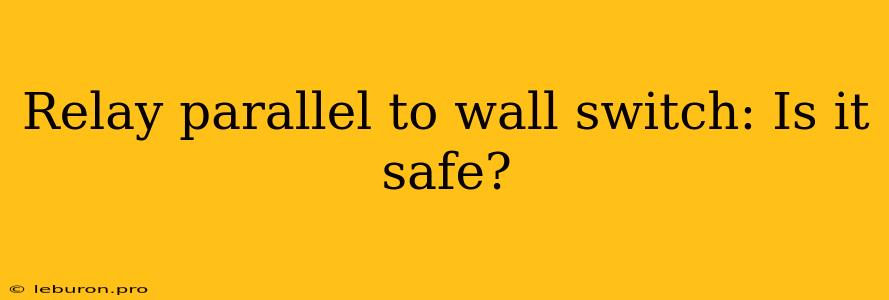The Safety of Installing a Relay Parallel to a Wall Switch: A Comprehensive Guide
The question of whether installing a relay parallel to a wall switch is safe is a common one amongst DIY enthusiasts and electricians alike. While it's true that this setup can provide added functionality and convenience, it's crucial to understand the potential safety implications and ensure proper installation practices. This article aims to provide a comprehensive guide to the safety aspects of installing a relay parallel to a wall switch, shedding light on the potential risks and how to mitigate them.
Understanding the Concept: Relay Parallel to Wall Switch
Before diving into safety concerns, it's essential to understand the basic concept of a relay parallel to a wall switch. A relay is an electrically controlled switch that can be used to control a circuit remotely. When a relay is connected parallel to a wall switch, it allows for independent control of the circuit. For instance, you could use the wall switch to turn a light on or off, and then use the relay to control a separate device or appliance connected to the same circuit. This setup often comes in handy for automating home appliances or incorporating smart home features.
Potential Safety Risks: Understanding the Concerns
While the concept of a relay parallel to a wall switch may seem straightforward, there are several potential safety risks associated with this configuration. These risks stem from the fact that both the relay and the wall switch control the same circuit, potentially leading to unexpected situations if not implemented correctly.
1. Short Circuits and Electrical Fires:
- The most significant risk associated with a relay parallel to a wall switch is the potential for short circuits.
- If the relay is not properly installed or experiences a malfunction, it could create a direct connection between the live and neutral wires, resulting in a short circuit. This could lead to excessive current flow, overheating, and potentially even electrical fires.
- Example: If the relay contacts get stuck closed due to a fault, the circuit would remain energized even when the wall switch is turned off, potentially causing a fire hazard.
2. Unexpected Circuit Activation:
- Another concern is the potential for unexpected circuit activation.
- If the relay is triggered accidentally or experiences a malfunction, the circuit could turn on without the user's knowledge, potentially causing danger.
- Example: Imagine a relay controlling a ceiling fan. If the relay malfunctions and turns the fan on while you are not aware, it could lead to accidents.
3. Overloading the Circuit:
- Overloading the circuit is also a potential safety hazard.
- If the relay is controlling a high-power appliance, it could overload the circuit, leading to damage or fire.
- Example: If the relay is used to control a space heater, and it malfunctions while the wall switch is also turned on, the circuit could be overloaded, potentially causing damage to the wiring or appliances.
Mitigating Risks: Ensuring Safe Installation and Operation
While the risks associated with a relay parallel to a wall switch are real, they can be effectively mitigated by following proper installation practices and implementing safety measures.
1. Use a High-Quality Relay:
- The first and most crucial step is to choose a high-quality relay from a reputable manufacturer.
- Ensure that the relay is specifically designed for your application and is rated to handle the load you intend to control.
2. Proper Wiring and Connections:
- Proper wiring and connections are essential to ensure that the relay is installed correctly and operates safely.
- Refer to the manufacturer's instructions for specific wiring diagrams and ensure that all connections are secure and properly insulated.
3. Overload Protection:
- Install a fuse or circuit breaker in the relay circuit to protect against overloading.
- This will help prevent excessive current flow and potential damage or fire in case of a malfunction.
4. Isolation and Grounding:
- Isolate the relay from the wall switch using a separate fuse or circuit breaker.
- This will help prevent cross-interference and minimize the risk of unintended circuit activation.
- Proper grounding is also essential for safety.
- Make sure the relay and all associated wiring are properly grounded to prevent electrical shocks.
5. Regular Maintenance:
- Regularly inspect the relay for signs of wear, damage, or corrosion.
- Maintenance checks can help identify potential problems early on and prevent safety hazards.
Conclusion: Safe and Efficient Operation
Installing a relay parallel to a wall switch can be a valuable solution for adding functionality and convenience to your home. However, it's crucial to understand the potential safety risks and take necessary precautions to mitigate them. By choosing a high-quality relay, ensuring proper wiring and connections, implementing overload protection, and performing regular maintenance, you can effectively address the safety concerns and enjoy the benefits of this versatile setup. Remember, safety should always be the top priority when working with electricity, and consulting a qualified electrician is always recommended for complex installations.
